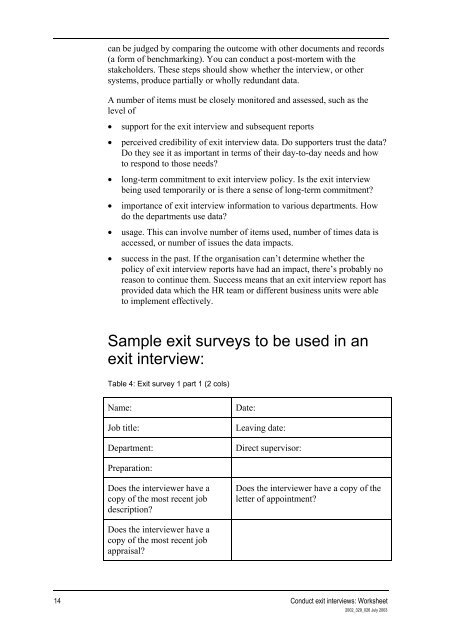Conduct exit interviews worksheet - Flexible Learning Toolboxes
Conduct exit interviews worksheet - Flexible Learning Toolboxes Conduct exit interviews worksheet - Flexible Learning Toolboxes
can be judged by comparing the outcome with other documents and records(a form of benchmarking). You can conduct a post-mortem with thestakeholders. These steps should show whether the interview, or othersystems, produce partially or wholly redundant data.A number of items must be closely monitored and assessed, such as thelevel of• support for the exit interview and subsequent reports• perceived credibility of exit interview data. Do supporters trust the data?Do they see it as important in terms of their day-to-day needs and howto respond to those needs?• long-term commitment to exit interview policy. Is the exit interviewbeing used temporarily or is there a sense of long-term commitment?• importance of exit interview information to various departments. Howdo the departments use data?• usage. This can involve number of items used, number of times data isaccessed, or number of issues the data impacts.• success in the past. If the organisation can’t determine whether thepolicy of exit interview reports have had an impact, there’s probably noreason to continue them. Success means that an exit interview report hasprovided data which the HR team or different business units were ableto implement effectively.Sample exit surveys to be used in anexit interview:Table 4: Exit survey 1 part 1 (2 cols)Name:Job title:Department:Date:Leaving date:Direct supervisor:Preparation:Does the interviewer have acopy of the most recent jobdescription?Does the interviewer have a copy of theletter of appointment?Does the interviewer have acopy of the most recent jobappraisal?14 Conduct exit interviews: Worksheet2002_329_026 July 2003
Table 5: Exit survey 1 part 2 (1 col)Position:Please outline the duties and responsibilities of your present position.Is this the sort of work you expected to be doing when you were offered thejob?Has the work you’ve been doing interested or challenged you?Is the actual work you have been doing different to your job description?Training:Would you like to comment on any aspect of your training or careersupport?Financial:How well do you think you have been paid for the work you do?Do you think your pay increased sufficiently during the job?Support:Do you feel your supervisor supported you when you needed support?How did your supervisor respond to any suggestions or complaints youraised?How well did your work group/team help your work?General:Would you tell me you overall feelings about the job and the organisation?Would you be prepared to remain in the job under a different arrangement –one that might be more satisfactory for you?If yes, what changes would you require?Conduct exit interviews: Worksheet 152002_329_026 July 2003
- Page 1 and 2: Conduct exit interviewsOverviewIt i
- Page 3 and 4: Issues and concernsMany problems as
- Page 5 and 6: The answers to these questions will
- Page 9 and 10: ResearchDoes your organization have
- Page 11 and 12: TechniqueUse doublesidedreflection.
- Page 13: Step 1—Review the feedbackData co
- Page 17 and 18: Reason forleavingPrimaryimportanceS
can be judged by comparing the outcome with other documents and records(a form of benchmarking). You can conduct a post-mortem with thestakeholders. These steps should show whether the interview, or othersystems, produce partially or wholly redundant data.A number of items must be closely monitored and assessed, such as thelevel of• support for the <strong>exit</strong> interview and subsequent reports• perceived credibility of <strong>exit</strong> interview data. Do supporters trust the data?Do they see it as important in terms of their day-to-day needs and howto respond to those needs?• long-term commitment to <strong>exit</strong> interview policy. Is the <strong>exit</strong> interviewbeing used temporarily or is there a sense of long-term commitment?• importance of <strong>exit</strong> interview information to various departments. Howdo the departments use data?• usage. This can involve number of items used, number of times data isaccessed, or number of issues the data impacts.• success in the past. If the organisation can’t determine whether thepolicy of <strong>exit</strong> interview reports have had an impact, there’s probably noreason to continue them. Success means that an <strong>exit</strong> interview report hasprovided data which the HR team or different business units were ableto implement effectively.Sample <strong>exit</strong> surveys to be used in an<strong>exit</strong> interview:Table 4: Exit survey 1 part 1 (2 cols)Name:Job title:Department:Date:Leaving date:Direct supervisor:Preparation:Does the interviewer have acopy of the most recent jobdescription?Does the interviewer have a copy of theletter of appointment?Does the interviewer have acopy of the most recent jobappraisal?14 <strong>Conduct</strong> <strong>exit</strong> <strong>interviews</strong>: Worksheet2002_329_026 July 2003



